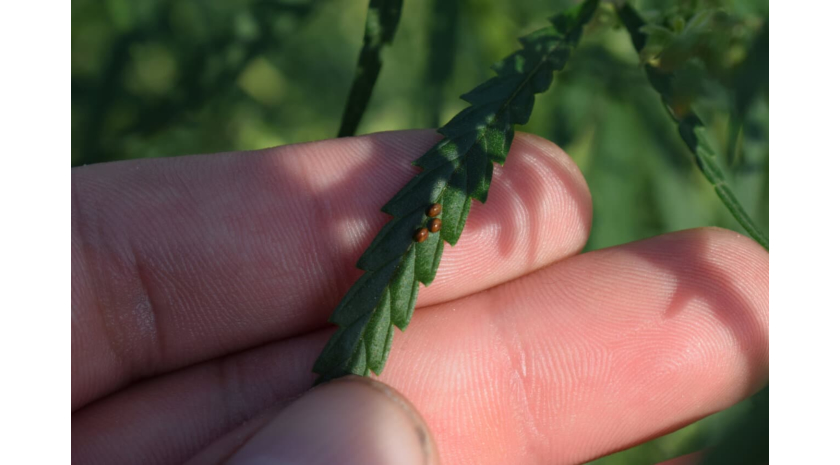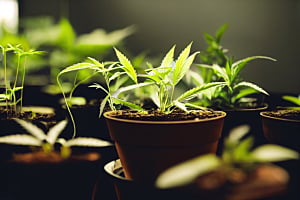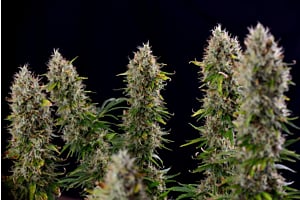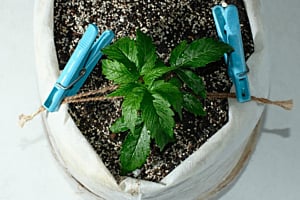We aren’t the only ones who love to consume a little pot. Cultivators are fighting a never-ending war against cannabis pests.
Marijuana pests have a detrimental impact on the health of your weed. They can kill entire crops, which isn’t only heartbreaking but also devastating for livelihoods.
Have you spotted a possible weed bug? Before you go reaching for the pesticides, take a moment to assess if you want to ingest chemicals. There are plenty of other more natural and organic ways of dealing with bugs in weed.
Learn how to stop pests and bugs in their tracks before they even reach your weed. If you have to let slip the dogs of war, you’ll need to know your enemy. Take a look at our cannabis pests identification catalog so that you can apply effective and fast treatments to rescue your crop.
How to get rid of marijuana pests
Threats to your cannabis come in all shapes and sizes throughout its lifecycle. Your weed plants are full of nutrients and make great habitats for cannabis bugs. You’ll rarely find a cultivator unused to cannabis pests.
Due to the sheer variety of insects hungry for your marijuana, it’s best practice to learn cannabis pests identification before starting your grow. Once you’re aware of the nasties coming for your plants, you can build a weed bug kit.
You should have to hand in your grow room:
- Neem Oil
- Essential IC3
- Pheromone traps
- Plant soaps or detergents
- Rubbing alcohol
- Ground garlic, mint, and coffee
These items will help to cure and control minor outbreaks of any cannabis pests that come knocking.
Other remedies include releasing natural predators into your grow area to eat up the bugs. Experienced cannabis cultivators will also make foliar sprays, combining natural pest deterrents with fertilizers to support plants’ overall health.
There isn’t a simple answer on how to get rid of bugs on weed plants. No one method or product holds the key to getting rid of all cannabis pests. Sometimes, you may need to use a combination of approaches.
Cannabis pests chart
Are cannabis pests ravaging your crop at this very minute? Take a look at our cannabis pests chart below for a quick ID so that you can go to battle right away.
|
Symptom |
Cannabis pests identification |
|
Leaves yellow and wilt |
|
|
Sooty mold appears as your plant's health declines |
|
|
Blistered growth that appears glossy and twisted |
|
|
Buds look ill fast and, when opened up, show signs of mold or death |
|
|
Holes in leaves and foliage covered in black spots (droppings) |
|
|
Burrows in soil or eaten leaves |
|
|
Plants become sick, discolor and droop |
|
|
Eaten leaves either from the outside in or holes all the way through |
|
|
Patches of grey discoloration appear all over |
|
|
Light-colored trails of discoloration |
|
|
Circular yellow or brown burn areas on your leaves |
|
|
Sooty mold appears alongside white clusters of webbing. New growth doesn’t mature. Leaves yellow, wilt, and die |
|
|
The entire crop gets sick. White cotton-like substance and chew marks cover stems |
|
|
Leaves discolor and wilt away. Roots brown, turn slimy, and smell bad |
|
|
Tops of plants droop, and upward growth fails to mature |
|
|
Scalloped, edged holes in leaves, and sticky |
|
|
White speckles on the surface of your leaves |
|
|
Bronze or silver patches appear |
|
|
Twisted leaves, slow growth, yellow mosaic pattern |
|
|
Leaves yellow, dry out, and fall off |
|
|
A white powdery substance on leaves and stems |
Prevention of the most common cannabis pests
Did you know that cannabis has a natural pest defense already? The glistening trichomes that cover your bud and secrete THC-rich resins are made by the plant not to get us high but to form a natural protection against threats like weed bugs.
They’re more successful at providing us with mind-bending experiences than stopping plant invaders, though.
Effective weed bug prevention starts with cannabis pest identification. By doing your homework, you’ll be able to make your grow area an inhospitable environment for cannabis pests from the get-go.
Growing indoors
Indoor grows are much more protected from bugs on weed plants but still aren’t invulnerable.
You should prepare your soil by topping it with strong-smelling materials like garlic, mint, and ground coffee—pests hate these. You can also add extra airflow into your room by placing fans so flying bugs can't land.
Introducing natural predators like ladybugs and lacewings into your grow room is beneficial in reducing the number of bugs on marijuana plants. They’re a great way to rid your room of anything that hitches a ride.
Growing outdoors
Cultivating outdoors puts your plants at a much higher risk of cannabis insects and diseases.
Give your plants an extra layer of protection outside by using a grow tent that allows sunlight and wind to pass through. Other cannabis pest control solutions include planting companion plants with natural pest deterrents alongside your weed.
Most common weed pests and how to eliminate them
It's time to put the most common cannabis pests under the microscope and discover how to identify and eradicate them from your crop.
1. Aphids
Aphids are small, soft-bodied, winged insects that change color depending on the stage of their lifecycle.
These weed bugs hide on the underside of your leaves and enjoy snacking on its sap. An outbreak can quickly drain the life out of your weed.
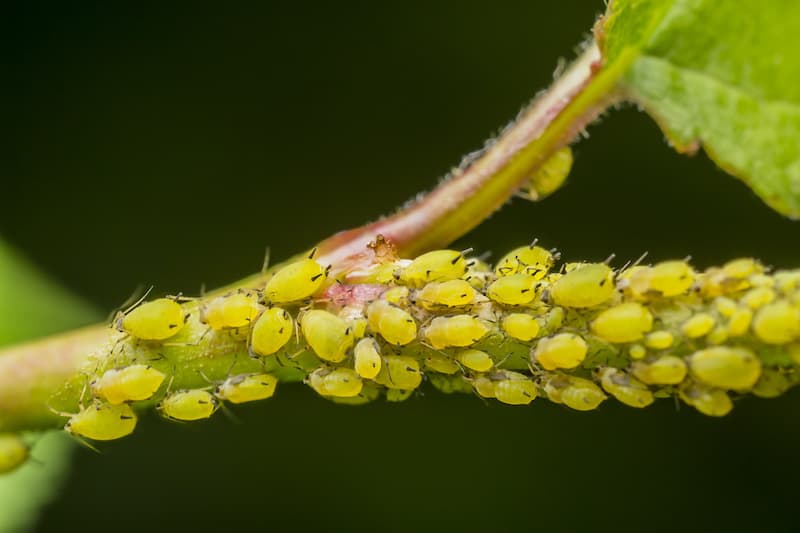
Symptoms
You may notice your leaf blades turning yellow; if so, turn them over to uncover colonies of these cannabis insects. Aphids also excrete brown spots of honeydew, attracting ants.
How to treat
You can crush aphids easily or wipe them away using a mix of rubbing alcohol and water. Alternatively, natural predators such as wasps, ladybugs, and aphid midges enjoy feeding on them.
2. Barnacles or scale insects
These cannabis bugs like to hang out on marijuana stems and the underside of leaves. Once in place, they remain unmoving while they suck the nutrients out of your plant, weakening its infrastructure.
Symptoms
You can spot an infestation easily by searching for unusual growths. If you notice your plant becoming floppy, bending, or generally looking ill, it's time to scan them for weed bug barnacles.
Honeydew spots luring ants and creating sooty mold is another sign you’ve got these weed bugs.
How to treat
Thanks to their size and strange appearance, these cannabis pests are easy to treat. You can simply scrape them off or use a pressure sprayer to blast them away.
Rubbing them over with a mix of rubbing alcohol and water or using neem oil and soaps kills them on the spot.
3. Broad mites
mites are one of the hardest cannabis pests to identify due to their microscopic size. The damage they cause can also be misdiagnosed for pH imbalances, root issues, or types of stress.
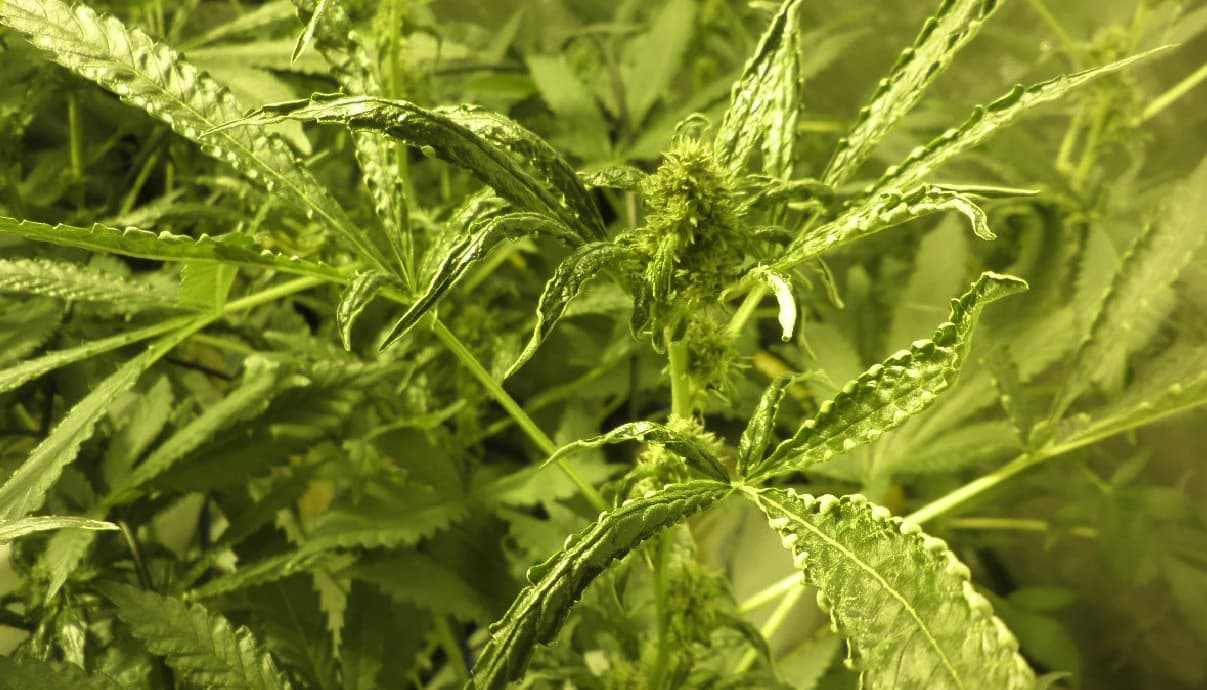
Symptoms
When your plant has these weed pests, new growth will appear twisted and droop. Older leaves will blister and look shiny and wet before curling.
If broad mites concentrate their attacks during the flowering stage, buds will become sickly and die.
How to treat
You should tackle this weed bug problem ruthlessly by removing any infected parts of the plant. Use essential IC3 or neem oil religiously every day and repeat for at least five weeks.
4. Bud rot or mold
Botrytis or bud rot is a mold that forms exclusively in the core of your plant’s buds during the flowering stage.
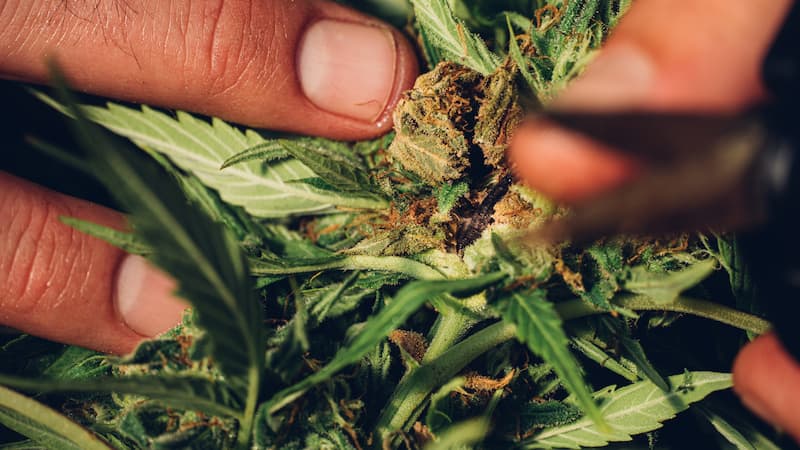
Symptoms
Unlike sooty mold, this marijuana pest is white and wispy in appearance. Your buds will start to break apart. Avoid these marijuana bugs by defoliating them at the base and center to allow aeration.
Once a cola has begun to mold, there isn't anything you can do other than throw it away to stop it from spreading.
5. Caterpillars & inchworms
Caterpillars and inchworms have insatiable appetites. Undetected, these cannabis pests can do a tremendous amount of harm in just one night.
Symptoms
Take the time to inspect your plants for black droppings, scalloped edge holes through leaves, and translucent egg clusters on the underside of leaves.
How to treat
Fortunately, these kings of speed eating are easy to remove by hand. You can also spray down your plants with garlic and pepper mists; alternatively, introduce Trichogramma wasps—they enjoy feasting on these weed pests.
6. Crickets
Regular crickets like to hang out in your weed plant branches and chew holes through leaves. In comparison, mole crickets will burrow through your soil and feast upon your plant’s roots.
Symptoms
These marijuana pests are the noisiest assailants of all. You’ll hear their distinctive chirp when the lights go down—a dead giveaway that you have these bugs in your marijuana plants. They also leave behind teeth marks and holes in your leaves.
How to treat
Cannabis pest control solutions for ridding your room of these noisy visitors include soaps, neem oil, and a pyrethrin-based spray mixed with spinosad.
7. Fungus Gnats
Fungus gnats hover around crops close to the ground. Larvae feed on fungi that grow around soil, hence the name.
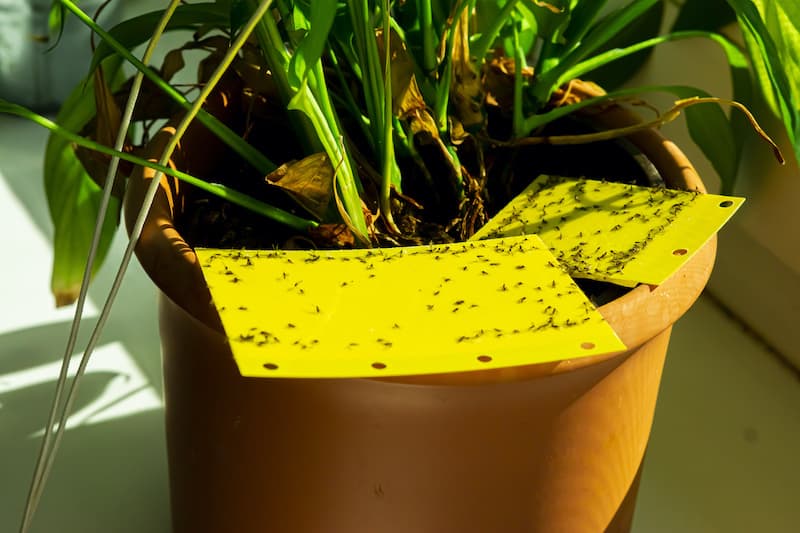
Symptoms
Your marijuana will become structurally unsound, tilt to one side, and growth will come to a halt.
How to treat
Sticky traps placed strategically at the base of your crop will catch the larvae and help reduce these cannabis bugs.
To kill the remaining adults, mix water and a drop of peroxide to create a spray. Apply to the infected areas.
8. Grasshoppers
Grasshoppers like to relax in the branches of cannabis plants. They have a hunger for marijuana and can chow your herbs fast.
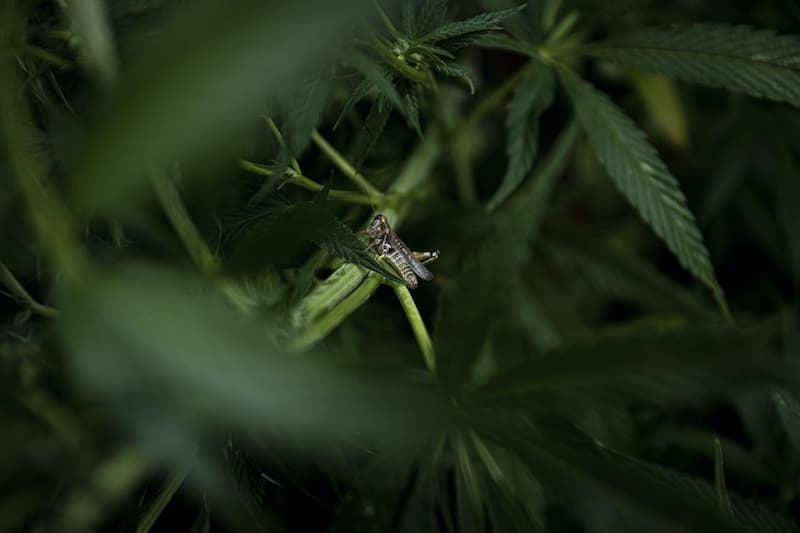
Symptoms
When these cannabis pests are hiding out in your plant, they’ll leave large noticeable chew marks in leaves and stems. They can quickly kill entire branches.
How to treat
The best way to rid your pot of these marijuana pests is to spray your crop down with organic pesticides like spinosad. To prevent grasshoppers from reaching your plant, you can install floating row covers.
9. Leafhoppers
There are thousands of species of leafhopper, which makes accurately identifying these bugs on weed plants tricky. No matter the color or shape, leafhoppers will always have six legs and wings.
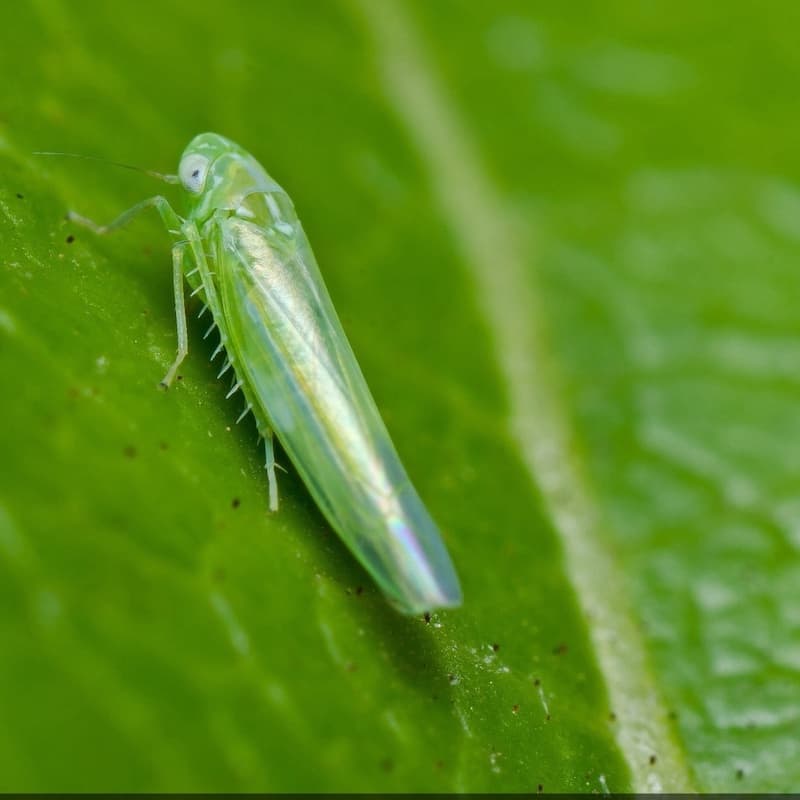
Symptoms
These cannabis pests spread disease as they suck the sap from your plant’s leaves. As they go, they create patches of silver or bronze with a saliva-like texture.
How to treat
Organic compounds like insecticidal soaps, neem oil, or rubbing alcohol are the most effective ways to kill these bugs on weed plants. Give your plants a spray down before introducing ladybugs and lacewings onto your grow.
10. Leaf miners
Mature leaf miners look like the common housefly and lay their eggs under leaves. When they hatch, the larvae burrow their way into the leaf, making tunnels as they move.
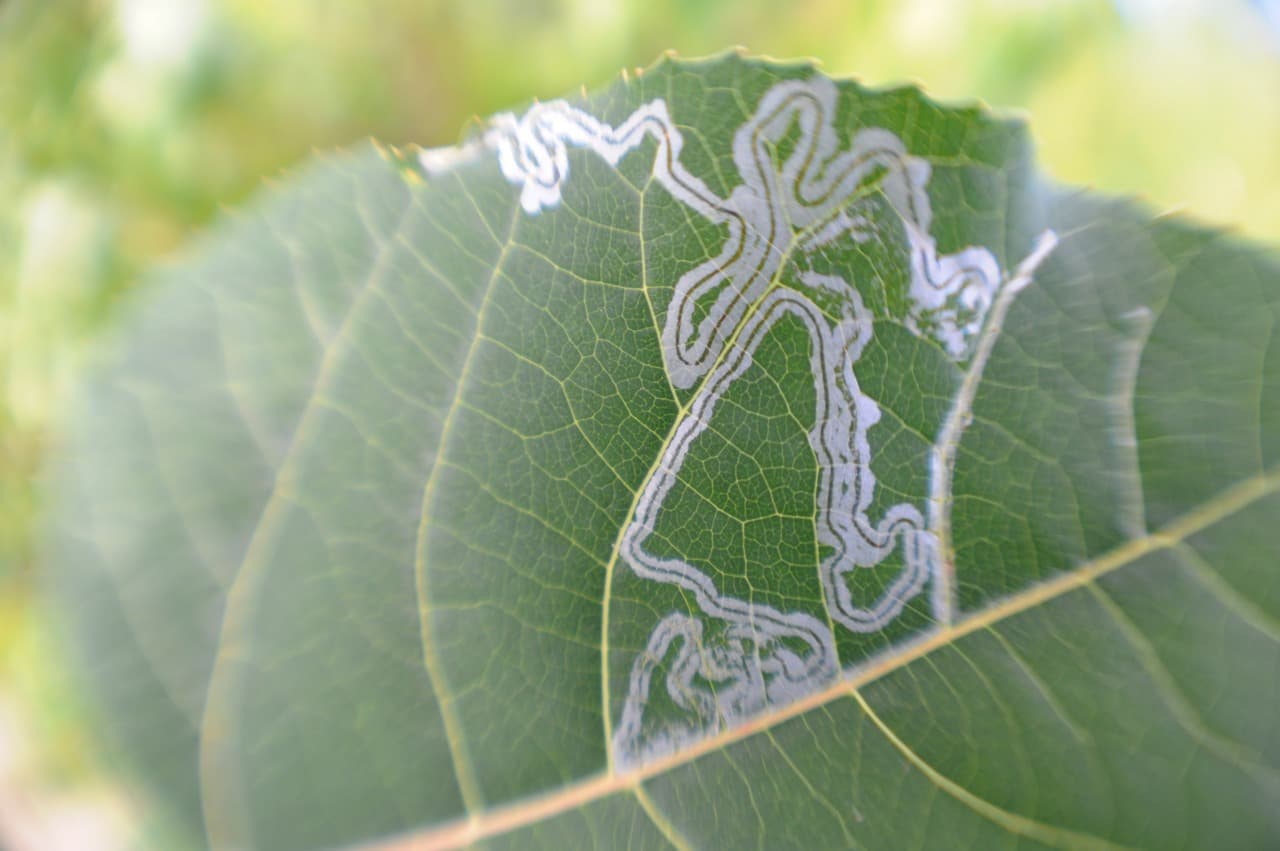
Symptoms
These cannabis insects leave mazes of brown and white streaks over your plants’ leaf blades.
How to treat
Place sticky pheromone traps around your crop to prevent these weed bugs from laying eggs. Hunt down the larvae and squish them inside their tunnels by hand.
11. Leaf septoria or yellow leaf spot
This marijuana pest is caused by a fungus that thrives in warm and wet conditions. Spores can stay hidden within soil over winter, ready to latch onto your plant in summer. They can also travel into your crop via wind and rain.
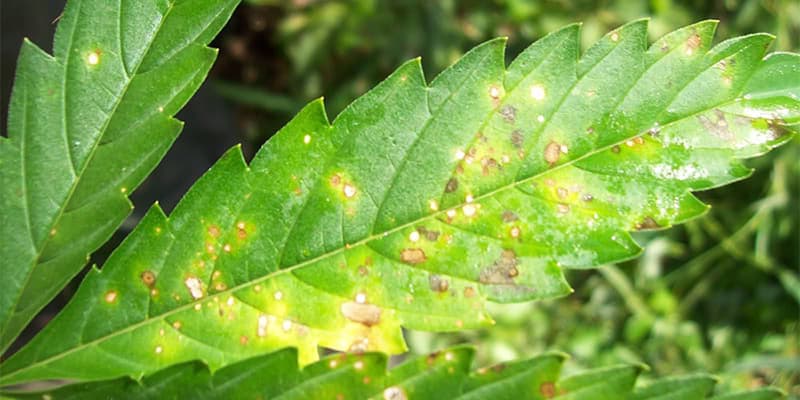
Symptoms
The bottom leaves of your weed plants will appear spotted with yellow hues with this marijuana pest. The circles are uniform with dark borders and often have a hard growth in the center, which is the fungus spore.
How to treat
Avoid getting too much water on your leaves, prune your weed leaves, and rotate your grow area regularly. Once this marijuana pest takes hold, isolate sick plants and spray your leaves with neem oil.
11. Mealybugs
Mealybugs look similar to woodlice, except these cannabis pests are slow-moving. They reproduce in the blink of an eye in warm climates and love every corner of your plant, including curing buds.
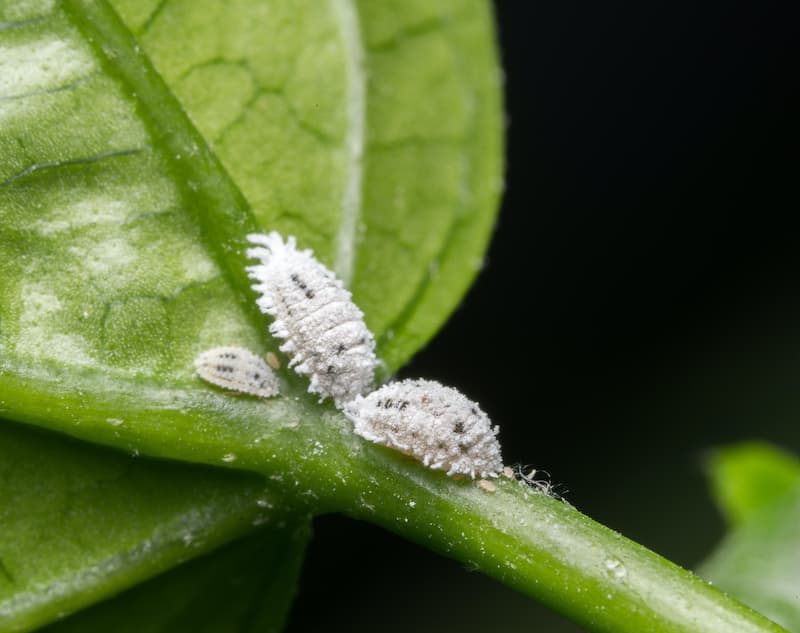
Symptoms
These common cannabis pests leave behind white webbing patches and honeydew all over your plant. Ants love to farm them for this substance, and sooty mold builds up as a result. If your plant has an infestation, leaves will yellow, wilt, and drop off.
How to treat
Start the treatment process by blasting the visible weed bugs off with water pressure. Then apply eco-friendly rubs like neem oil, soaps, and rubbing alcohol.
12. Planthoppers
Planthoppers are the masters of disguise. There are many different species of these weed bugs, and they change color throughout their lifecycle. One thing remains the same: they always camouflage and shape themselves to look like part of your plant.
Symptoms
These cannabis insects will quickly turn your lush green plants into sickly yellow ones as they suck out nutrients and spread disease. They leave fuzzy white secretions that can be misdiagnosed as mold or powdery mildew.
How to treat
Floating row covers are the most effective way to prevent these bugs in weed from squatting there too long. If it’s too late to lock them out, then you’ll need to spray down your crop with neem oil or spinosad before releasing natural predators.
13. Root rot
Root rot can take hold of your potted marijuana if you over water, but weed grown in a hydroponics system is most at risk of this marijuana pest. Like algae, oomycetes, fungi, and bacteria, pathogens in your tank are usually to blame.
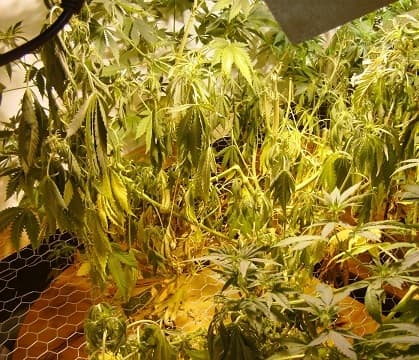
Symptoms
When this marijuana pest sets in, the roots will be brown, slimy, and give off a pungent odor. Leaves will droop and turn yellow before dropping off.
How to treat
Prevention is the key to avoiding this marijuana pest. You need to ensure your hydro water stays cool, oxygenated, and your DWC reservoir receives no light. If there are symptoms, you should immediately treat the rootstock with hydro guard and introduce beneficial bacterias into your system.
14. Russet mites
Russet mites are tiny weed bugs that accumulate in hoards around the buds, leaves, and stems of your cannabis.
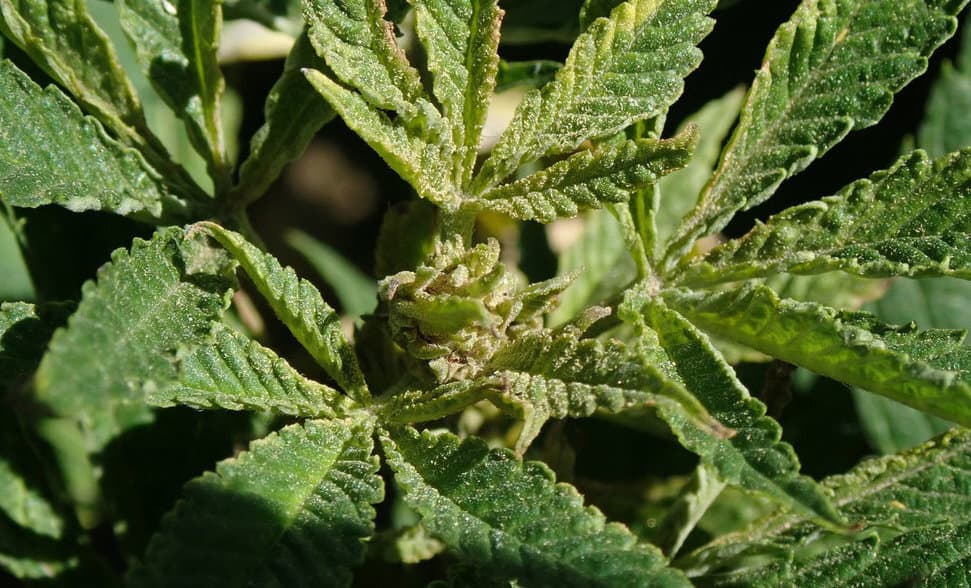
Symptoms
When these marijuana pests are present, masses of yellow or beige clusters cover your plant. Leaf edges will curl, and foliage will droop, often making the top of your weed bend over on itself. Your plant will be brittle, and signs of stress will appear as yellow or brown spots.
How to treat
These weed pests are a nuisance to eradicate as they lay their eggs inside your weed’s cell structure. You need to remove affected areas and treat your crop before lights out for five weeks with essential IC3.
15. Slugs or snails
Slugs and snails are common cannabis pests. Left to their own devices, they can quickly ravage your crop.
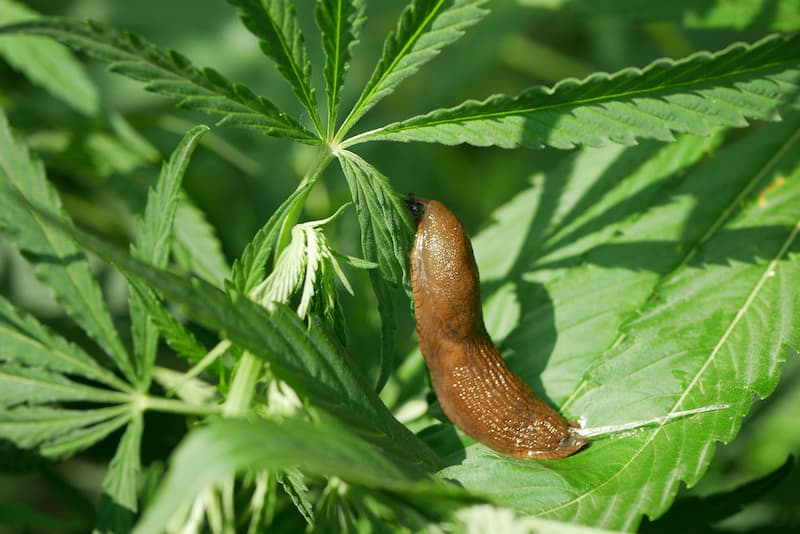
Symptoms
Look for translucent trails and chew holes in your leaves.
How to treat
Prevent them from entering your grow area with barriers and repellents. You can also lure them into one zone with baits and humanly dispose of them.
16. Spider mites
Another one of the most common cannabis pests is spider mites. They multiply fast and mature within a week. As they move around your crop, they feast on chlorophyll and valuable nutrients.
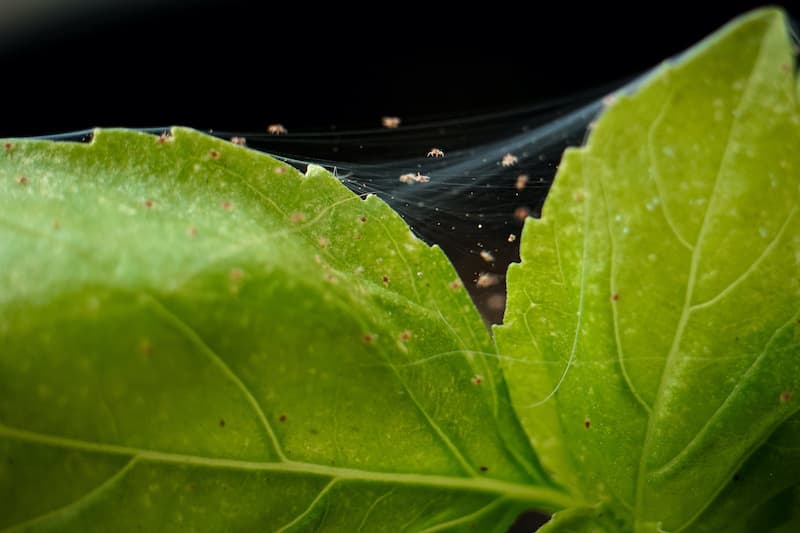
Symptoms
Not to be confused with a cannabis deficiency, these bugs on weed plants leave behind a white speckled pattern across the top of leaf blades, while underneath, you’ll notice black or red dots.
How to treat
Weed bug predators like ladybugs love to eat them. You can also rub or spray them away with neem oil, potassium salt, rubbing alcohol, or a good dose of water.
17. Thrips
It’s a challenge to get rid of thrips once they settle into your cannabis. These bugs on marijuana plants are tiny, fast, hard to spot, and spread diseases. They have an appetite for your weed flowers and don’t care about your yield.
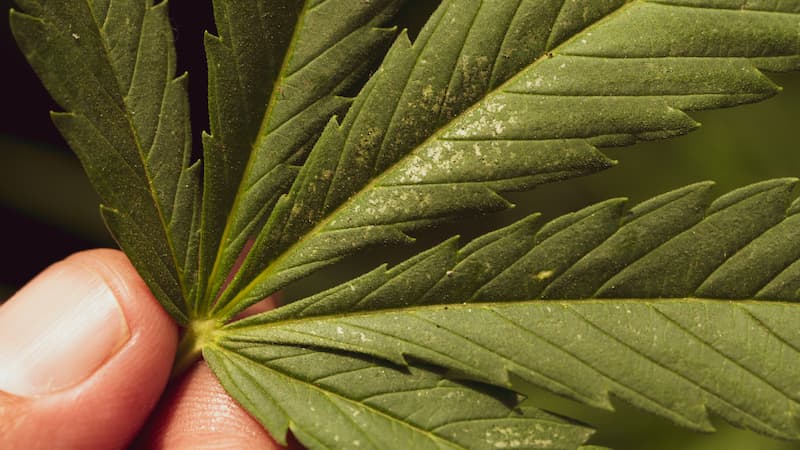
Symptoms
Your plants’ leaves become brittle and present silver markings.
How to treat
If you identify an invasion before the flowering stage begins, spray your marijuana down with potassium soap or neem oil immediately. If buds have already formed, you’ll need to take alternative cannabis pest control measures such as releasing wasps into the growing area.
18. Tobacco Mosaic Virus (TMV)
TMV is associated with Tobacco crops. Although evidence of it in cannabis plants is rare, many cultivators claim their crops have caught it.
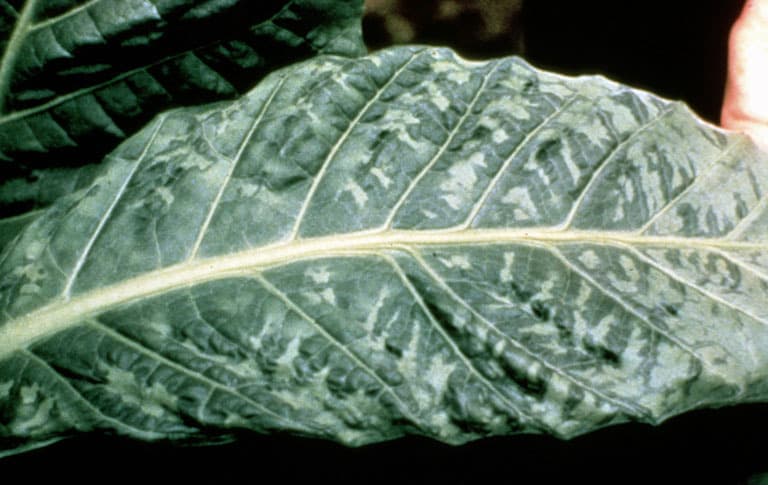
Symptoms
Blades display a unique yellow mosaic pattern, and general growth will slow down.
How to treat
There’s no cure for TMV, and you should dispose of infected plants and the soil they were growing in immediately. To prevent this marijuana pest from entering your grow zone, you should always wash your hands before touching your pot and in between handling each plant.
19. Whiteflies
Whiteflies are common cannabis bugs that suck the sap out of leaves and spread disease. They hang onto the underside of foliage and eventually weaken your weed.
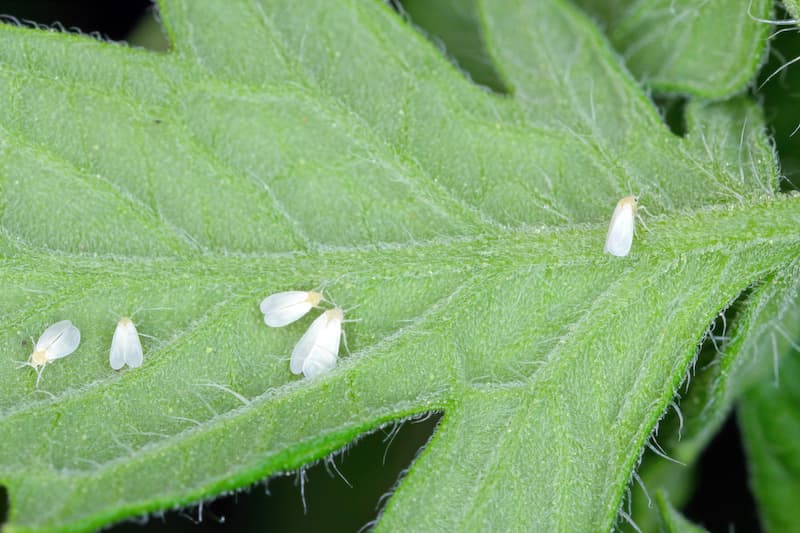
Symptoms
They are easily spotted hovering around your weed when you shake it; they also leave behind a white powder which causes the yellowing of leaves.
How to treat
Companion plants like basil are a great way to deter these weed pests naturally. You can also rub down any infected leaves with soaps and neem oil.
20. White powdery mold
White powdery mold is a fast-spreading marijuana pest.
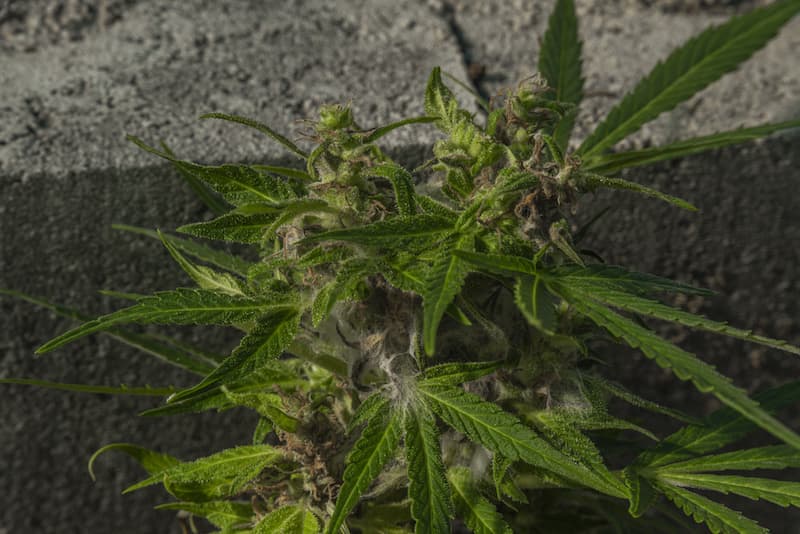
Symptoms
It creates large white patches of fungal growth.
How to treat
Be careful not to disturb the area and quarantine infected plants. The white patches contain countless spores that can quickly circulate your grow room and infect other plants.
Wipe away the build-up using water and hydrogen peroxide, SM-90, neem oil, milk, or baking soda.
Win the war on cannabis pest control
An entire party of marijuana bugs is gunning for your plants and lurks in waiting for a feast. Prevention is always better than the cure, so deny cannabis pests the opportunity to latch onto your pot.
Take the time to plan out your grow room, install fans, companion plants, floating row covers, sticky traps, and anything else you think might stop cannabis insects from making themselves at home.
Consider releasing predatory insects and stock up on eco-friendly organic pesticides and weed bug remedies to keep pests off your cannabis plants.
Remember to stay clear of chemical pesticides. These run havoc on the ecosystem and can make your harvest inedible. Next time you spot an uninvited visitor in your grow area, refer to our handy cannabis pests chart for quick answers to cannabis pest control solutions. Mission accomplished.

 THC
THC THCA Flower
THCA Flower